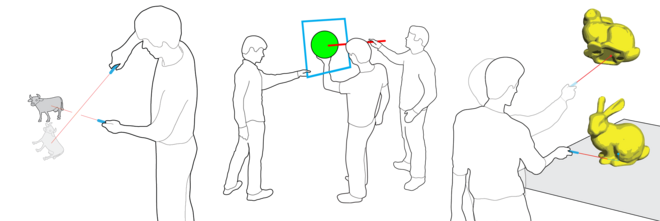Prof. Dr. Bernd Fröhlich
Dr. André Kunert
Dr. Alexander Kulik
M.Sc. Ephraim Schott
M.Sc. Sebastian Stickert
Description
3D Digital Content Creation seems to be slowly moving from desktop workplaces to more immersive environments, where users can change the whole world, which they are experiencing, including interactive behaviors. An increasing number of modeling applications build on the potentials of virtual reality (VR), but standards are yet to emerge. While 3D input gestures are more expressive, users are trading in precision and perhaps even comfort in comparison to desktop interfaces. This calls for different approaches to content creation and management, e.g., smart corrections of approximate content placement or applications of different styles to more semantic geometric structures.
Interaction rapidity can even be key in many applications, e.g., to maintain flow in playful social settings. Collaborative 3D modeling should emphasize the expressive, communicative value of 3D sketches over accuracy in the context of social gatherings.
In this project, we will review available applications and suggested 3D interaction techniques towards the collaborative creation of interactive virtual environments. We will evaluate the benefits and drawbacks of the various approaches and implement a set of promising techniques in a social VR space using Unity and the portable Oculus Quest.
Results
Our students Karoline Brehm, Emil Reinert, Omar Nada, and Tony Zöppig started their investigation by exploring related consumer applications. Along their observations and given academic related work, the group proceeded to identify qualitative factors involved with collaborative content creation as well as social virtual reality.
After identifying problem spaces with respect to modes of interaction, shared object management, gestures and technical requirements, an outlook towards a contribution for this project was initially drafted. Using agile software engineering principles, the group incrementally implemented and refined their concepts and prototypic implementation.
The team was successful in designing a comprehensive toolset for collaborative content management in social VR. Several tools such as mock-up sketches, diagrams and intermediate presentations guided the discussion, refinement and prioritization of ideas. As a result, a final demo was developed. It was implemented using Unity and runs on the Oculus Quest 2 HMD. In the (VR) CreatIVE application, multiple physically distributed users can build their own virtual environment together.
Due to time constraints, no formal user study was conducted, yet the video below showcases the effectiveness of the interaction design envisioned and realized by our students. Their excellent conceptual and practical efforts lead great potential for future research and development at our chair.

(VR) CreatIVE: Collaborative Content Creation in VR
from Virtuelle Realität
Click the Play button to load and view external content from Vimeo.com.
Automatically load and view external content from Vimeo.com (You can change this setting at any time via our »Data protection policy«.)

